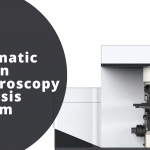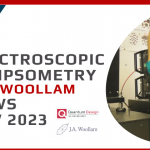

Thickness is a crucial quality parameter in thin films and coatings. The thickness and homogeneity strongly affect the film’s functionality and they need accurate monitoring. X-ray techniques and optical spectroscopy are in wide use for this purpose both in tabletop and in-line inspection systems.
However, only point sensors are currently employed and, for in-line applications, are typically mounted on a scanning transversal stage, leading to a zigzag inspection pattern. The film under inspection is thus only partly monitored.


A line-scan (push-broom) hyperspectral camera can overcome this limitation and inspect the full film or coating. In each line capture, spectroscopic data over the full film width is produced at high spatial resolution.
To demonstrate hyperspectral imaging in this application, Specim measured four polymer thin film samples with a spectral camera operating in the region of 935 – 1700 nm (Specim FX17). The sample films’ nominal thicknesses were 17, 20 (two films), and 23 um. Specular geometry was used, and interferences were scrutinized. Depending on the spectral position and distance between constructive interferences, the thickness can be deduced:


𝛌p as a wavelength in nm where a maximum is, indexed p. n is the refraction index of the film material α is the incidence angle of the specular setup
The spectral interference patterns, measured in specular reflection, were converted into a thickness map.


Spectral interferences were converted into a thickness heat map with Matlab. The average thicknesses calculated from the FX17 spectral data were 18.4, 20.05, 21.7, and 23.9 um. The standard deviation was 0.12, 0.076, 0.34 and 0.183 um, respectively. When the films were measured, they were not stretched. This may explain why measured values are slightly over nominal ones. Besides, defects were also detected. In film 1, we detected two thin groves, probably caused by local pressures.


Hyperspectral imaging will significantly enhance current thin-film efficiency and coating quality control systems based on optical spectroscopy. As hyperspectral cameras (like Specim FX17) can acquire up to thousands of line images per second, they can provide 100% in-line inspection of thin films for increased consistent quality and reduced waste.
They will also enable significantly higher speed tabletop inspection systems than current XY scanning solutions based on a point spectrometer. Hyperspectral cameras also eliminate harmful radiation risks of X-ray sensors as only innocuous optical light is required.
Theoretically and considering a safe margin, FX10 can measure thickness ranging from 1.5 to 30 um, whereas FX17 would be suitable for thicknesses ranging from 4 to 90 um.


Contact Sales Manager Ashley Crane to discuss your application: ashley@qd-uki.co.uk






